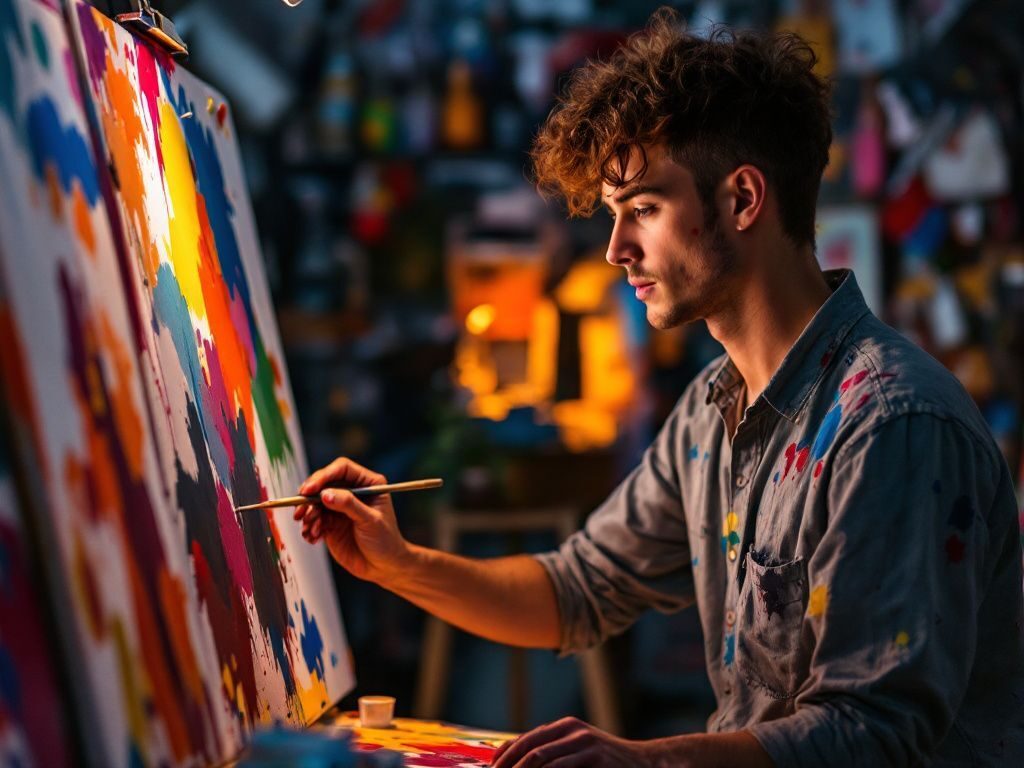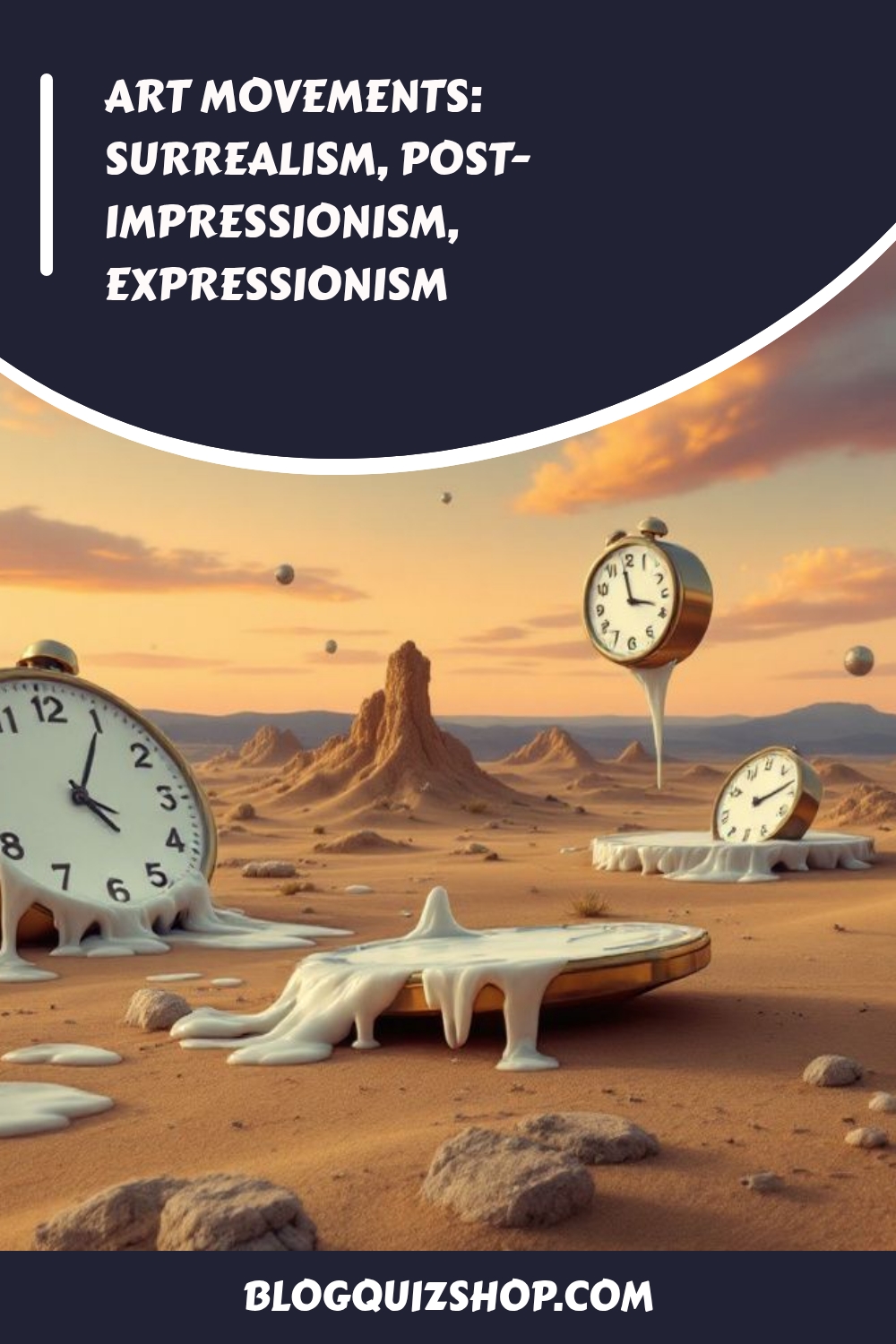- The art movements discussed – Impressionism, Post-Impressionism, Expressionism, and Surrealism – were revolutionary, pushing art beyond strict realism.
- These movements aimed to capture the immediate effects of light and color, express inner feelings and intellectual ideas, and eventually explore the subconscious mind.
- They collectively contributed to the foundation and evolution of modern and contemporary art by consistently challenging artistic norms.
Impressionism (Late 19th Century France)
- Impressionism emerged in the late 19th century in France, and led to the Post-Impressionism movement. This was a period of significant change due to the Industrial Revolution, with Paris as a cultural center.
- It was a rebellion against dominant art styles like Realism, which focused on detailed and accurate depictions of life.
- In 1874, a group of artists, calling themselves the “Anonymous Society of Painters, Sculptors, Printmakers, etc.,” held their own exhibition in Paris, challenging the official Salon, which dictated what was considered good art.
- Key Impressionist artists included Monet, Degas, and Pissarro.
- They aimed to make art more democratic and immediate, holding eight independent exhibitions between 1874 and 1886.
- The term “Impressionism” was initially a mocking insult by a critic reacting to Monet’s painting “Impression, Sunrise,” but the name stuck and perfectly captured the movement’s goal: to seize the fleeting moment.
- The movement focused on capturing contemporary life and the immediate effects of light and color spontaneously, diverging from traditional art’s focus on history or mythology, which was typically highly polished.
- Two major innovations enabled this: portable paint tubes, allowing artists to paint outdoors (en plein air), and advancements in color theory, including new synthetic pigments that allowed for brighter, more vibrant colors, making it possible to paint light itself.
- Impressionist paintings are characterized by loose, visible brushstrokes, conveying a sense of immediacy and spontaneity.
- They rendered shadows and highlights using color, avoiding neutral tones, to mimic how the human eye perceives light and movement.
- Common subjects included lively scenes of everyday life, cafes, dances, landscapes, and cityscapes.
- Renoir’s “Dance at Le Moulin de la Galette” vividly captures dappled sunlight on dancers.
- Caillebotte’s “Paris Street; Rainy Day” offers a sweeping view of modern Paris.
- Monet’s “Rouen Cathedral” series and “Water Lilies” exemplify the study of how changing light altered the color and texture of subjects at different times of day and seasons, emphasizing light and natural colors.
Post-Impressionism (Late 1880s – Early 1900s)
- Post-Impressionism emerged in the late 1880s, roughly from 1886 to 1905, as a reaction to Impressionism.
- While Impressionism was revolutionary, some artists felt it was superficial, focusing too much on observation rather than deeper meaning. Thus the Post-Impressionism movement was formed.
- The Post-Impressionism artists sought to express inner feelings, emotion, and symbolism, moving beyond merely capturing the surface appearance of reality.
- Key artists of Post-Impressionism included Van Gogh, Cézanne, Gauguin, and Seurat.
- Unlike the Impressionists, Post-Impressionists were not a cohesive group but shared common artistic goals and often exchanged ideas.
- They departed from Impressionism and moved into Post-Impressionism by taking color “beyond natural observation,” using it symbolically and expressively. This was to convey mood, emotion, and meaning in their Post-Impressionism artworks, rather than just showing how something looked.
- Van Gogh’s “The Starry Night” uses swirling blues and intense yellows that are not realistic but evoke powerful feelings. They are of wonder, turmoil, and spirituality in a Post-Impressionism artwork.
- Gauguin’s works, like “When Will You Marry?”, use saturated, dreamlike colors to tell a story rather than just paint a scene.
- The motivation shifted from capturing an impression of a moment to using color and form to communicate the scene’s emotion, making the viewer feel it.
- Van Gogh’s “The Night Cafe” (with its clashing reds and greens) aimed to create an uncomfortable feeling, expressing the “terrible passions of humanity.”
- Post-Impressionism artworks simplified forms, used bolder compositions, and reintroduced structure and symbolism, even hinting at abstraction.
- Cézanne broke down objects into geometric shapes (cylinders, spheres, cones) to find a sense of solidity and permanence beneath the fleeting surface, giving structure back to painting.
- Seurat developed Pointillism, using thousands of tiny dots of color that the eye optically mixes when viewed from a distance, as seen in “A Sunday on La Grande Jatte.”
- Post-Impressionism significantly broadened the scope of art, laying the groundwork for subsequent movements like Cubism and Fauvism, and kickstarting modern art.
Expressionism (Early 20th Century Germany, c. 1905)
- Expressionism emerged in Germany around 1905 as a direct reaction against Impressionism, reflecting the anxieties of early 20th-century life, including rapid industrialization, urbanization, new technologies, anxiety, and alienation.
- It prioritized the artist’s subjective emotion over objective reality, aiming to express inner turmoil and confront uncomfortable truths.
- The focus was intensely personal and subjective, distinct from previous art movements.
- Influential artists included Symbolists like Gauguin, Edvard Munch, and particularly Van Gogh.
- Expressionist art is characterized by distorted, exaggerated forms, twisted landscapes, and objects to maximize emotional impact, sometimes appearing grotesque or nightmarish.
- Color was intense, non-naturalistic, and chosen purely for its expressive power, often clashing, jarring, or dark.
- Brushwork remained loose like in Impressionism but became more vigorous, rapid, and often featured thick layers of paint (impasto), allowing the artist’s gesture, energy, and mood to be visible.
- Jagged, angular lines were prominent, particularly in German Expressionism, to heighten tension and evoke feelings of instability and psychological unrest.
- Common themes included anxiety, alienation, and violence, reflecting the anxieties of the modern age.
- Key groups within Expressionism included:
- Die Brücke (The Bridge): Formed in Dresden in 1905 by four architecture students, including Kirchner (main figure), Schmidt-Rottluff, Bleyl, and Heckel. They aimed to “bridge” to the future of art, breaking from tradition and expressing inner feelings directly, inspired by African wood carvings and old German woodcuts. They favored bold, graphic styles, especially in woodcuts and linocuts.
- Der Blaue Reiter (The Blue Rider): Formed in Munich in 1911, led by Wassily Kandinsky and Franz Marc. It was less formally organized, with a more spiritual focus. They published “The Blue Rider Almanac” in 1912, showcasing expressive art from diverse cultures and times, advocating for a universal, spiritual quality in art regardless of style. This group was short-lived, dissolving with World War I, which also claimed the lives of Marc and August Macke.
- Prominent individual Expressionists included Edvard Munch, whose “The Scream” is considered the ultimate Expressionist image, capturing raw existential anguish with its distorted figure and blood-red sky.
- Kandinsky pushed towards abstraction, using color and form to evoke sound, emotion, and spiritual states rather than depicting objects, as seen in “Composition VII” which embodies pure energy and color.
- Austrian Expressionists, like Egon Schiele, created incredibly intense, raw, and psychologically probing works, often featuring nude self-portraits exploring vulnerability.
- Expressionism’s initial post-war angst lessened, but its true end in Germany came with the Nazis’ rise in 1933, who labeled it “degenerate art” (Entartete Kunst). Thousands of works were confiscated or destroyed, and artists were forced into exile; Kirchner tragically took his own life.
- Despite suppression, Expressionism’s influence resurfaced in movements like Abstract Expressionism (Pollock, Rothko) and Neo-Expressionism (Baselitz, Basquiat).
- Its influence extended beyond painting to literature, architecture (with its unconventional shapes), music (Schönberg exploring dissonance), and German Expressionist cinema (1910s-1920s), which used techniques like the “Dutch angle” to create unease and tension, influencing film noir and directors like Tim Burton.
Surrealism (Europe, 1920s)
- Surrealism officially began in Paris in 1924, led by writer André Breton.
- It emerged in Europe right after World War I, a time of immense trauma, loss, and disillusionment, with artists seeking ways to cope or escape reality.
- The movement looked inward, exploring the subconscious mind, heavily influenced by Sigmund Freud’s theories on the subconscious and dream interpretation.
- Breton, who had studied medicine and was fascinated by psychoanalysis, based Surrealism’s philosophy on Freud’s ideas, defining it as “pure psychic automatism,” meaning expressing thought without conscious control, reason, morality, or aesthetic concerns, allowing the subconscious to speak directly.
- “Surreal” literally means dreamlike, bizarre, or unreal.
- The goal was to merge dream and reality into a “super reality,” or surrealité, to shock, surprise, challenge norms, and celebrate unconventional ideas.
- Key techniques to access the subconscious included:
- Automatism: Automatic writing or drawing, letting the hand move freely without planning, similar to improvisation but visual, allowing instinct to take over.
- Juxtaposition: Placing completely unrelated things together in unexpected ways, creating visual shock that could be funny or unsettling (e.g., Dali’s “Lobster Telephone,” or Meret Oppenheim’s “Object” (fur-covered teacup)).
- Found Objects/Assemblage: Using everyday objects, altered slightly, often to create sculptures (assemblage).
- Direct Dream Painting: Translating the illogical, symbolic scenes from dreams onto canvas, following the logic of the unconscious.
- Salvador Dalí was a central figure, known for “The Persistence of Memory” (melting clocks, ants suggesting decay), which is dreamlike, unsettling, and full of symbolism. Dalí also developed the “paranoiac-critical method,” claiming he could induce paranoid or hallucinatory states to access irrational images for his paintings.
- René Magritte focused on ideas, particularly “the treachery of images,” as seen in his painting of a pipe with the caption “Ceci n’est pas une pipe” (This is not a pipe), forcing contemplation on representation versus reality. His painting “Golconda” features men raining down, a realistic technique with a totally surreal concept.
- Frida Kahlo’s intensely autobiographical work, like “The Two Fridas” (exposed hearts, dripping blood) and “The Wounded Deer” (herself as a deer pierced by arrows), made emotional pain visible, processing trauma through art.
- Man Ray, the American Surrealist, was known for his photography and objects like “Indestructible Object” (a metronome with an eye), which was later remade as “Object to Be Destroyed” after a breakup.
- Remedios Varo painted intricate, magical scenes infused with alchemy and magic, inspired by older painters like Hieronymus Bosch.
- Max Ernst created whole surreal worlds through collages, notably his collage novel “Une Semaine de Bonté,” which combined old Victorian book images into bizarre, dark, dreamlike narratives.
- Surrealism has had a massive impact, extending beyond fine art into advertising (dreamlike visuals, unexpected combinations), fashion (Elsa Schiaparelli’s collaboration with Dalí on the lobster dress), and general popular culture.


 Cart is empty
Cart is empty 







